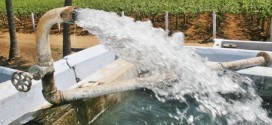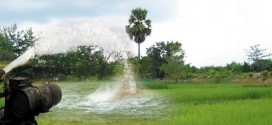The forces with which water is held in soils determine its availability to plants. Forces of adhesion hold water strongly to mineral and humus surfaces and less strongly to itself by cohesive forces. A plant’s root may penetrate a very small volume of water that is adhering to soil and be initially able to draw in water that is only lightly held by the cohesive forces. But as the droplet is drawn down, the forces of adhesion of the water for the soil particles make reducing the volume of water increasingly difficult until the plant cannot produce sufficient suction to use the remaining water. The remaining water is considered unavailable. The amount of available water depends upon the soil texture and humus amounts and the type of plant attempting to use the water. Cacti, for example, can produce greater suction than can agricultural crop plants.
The following description applies to a loam soil and agricultural crops. When a field is flooded, it is said to be saturated and all available air space is occupied by water. The suction required to draw water into a plant root is zero. As the field drains under the influence of gravity (drained water is called gravitational water or drain-able water), the suction a plant must produce to use such water increases to 1/3 bar. At that point, the soil is said to have reached field capacity, and plants that use the water must produce increasingly higher suction, finally up to 15 bar. At 15 bar suction, the soil water amount is called wilting percent. At that suction the plant cannot sustain its water needs as water is still being lost from the plant by transpiration; the plant’s turgidity is lost, and it wilts. The next level, called air-dry, occurs at 1000 bar suction. Finally the oven dry condition is reached at 10,000 bar suction. All water below wilting percentage is calledunavailable water.
 Karshika Keralam – A site for Agricultural Enthusiasts
Karshika Keralam – A site for Agricultural Enthusiasts

